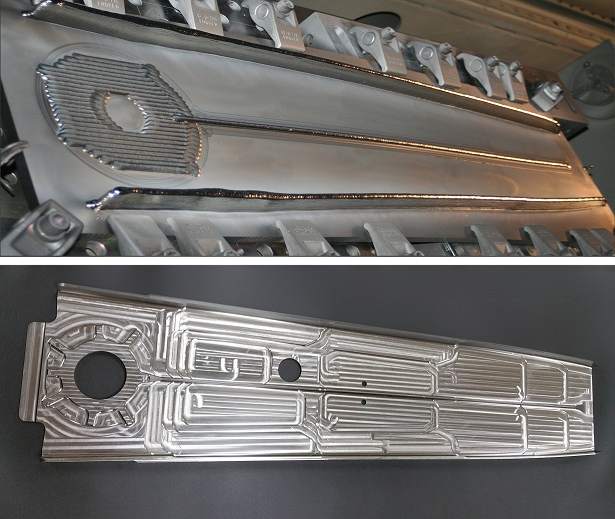Hailing from Chicago, Illinois, Sciaky have been providing industrial scale manufacturing solutions to companies since 1939. Throughout the Second World War, the company supplied its welding systems to make U.S. warplanes, and subsequently developed its proprietary Electron Beam welding system throughout the 1950s. This time-tested technology has now evolved into Electron Beam Additive Manufacturing (EBAM) machines with primary uses in the manufacturing of aircrafts for public and defense aerospace companies.
GIF shows ‘Sciaky’s Electron Beam Additive Manufacturing (EBAM™) Solution’. Clip via: SciakyInc on Youtube
The EBAM printer
Sciaky’s EBAM 110 System is now being delivered to multinational airplane manufacturers Airbus. The 110 System works by melting down a range of alloy metals into layers to build up a structure. The ‘filament’ used can be any weldable metal in a wire format, including titanium, stainless steels, tungsten, copper nickel and Inconel 718 – which is the same material being researched by the University of Pittsburgh with $500,000 funding from NASA.
Airbus’ special interest
Airbus’ interest in the system is in its capability to work with strong, light metals suitable for use within the construction of wings, tails and fins. Pictured below is a Sciaky EBAM titanium spar part which forms main skeletal structure of an Airbus wing.

The 110 System is also valued for its 5.83 ft. 3.91 x 5.2 ft. build size, for perhaps fabricating bigger parts of the fuselage, or even consolidating multiple parts into one seamless print. The machine also uses a Interlayer Real-time Imaging and Sensing System which can self-adjust the deposition of material without human input.
Collaboration with Sciaky adds to Airbus’ existing additive manufacturing partnerships with Stratasys and Arconic, through which the airline manufactures both metal and high-grade plastic parts.
Cutting costs
With additive manufacturing, aerospace clients are especially pleased with how the method cuts down on lead times, also meaning that they are able to cut down on financial cost.
RyanAir airlines chief executive Michael O’Leary has asserted that flights may be free of charge within the next decade:
If [air passenger duty] is gone: at many airports I’m paying more than £20 already with APD and fees, if I start getting that back, why not? I’m doing seat sales this week at £4 and I’m paying the £13 APD – I’m paying you to fly with me. Instead of promotional tickets being £9 or £5 they will be free.
Affiliation with airports will instead pay for the planes and the amount of traffic brought in by their service, so a reduce manufacturing cost may become even more vital to an airline’s ability to survive. As Sciaky marketing vice president Bob Phillips, comments in a statement about the delivery of the 110 System:
We all know that metal 3D printing technology is going to revolutionize manufacturing in the aerospace industry, and Sciaky is committed to being at the forefront of this movement.
Featured image shows the inner construction spar of an airplane wing. Photo by wikipedia contributor Peripitus



